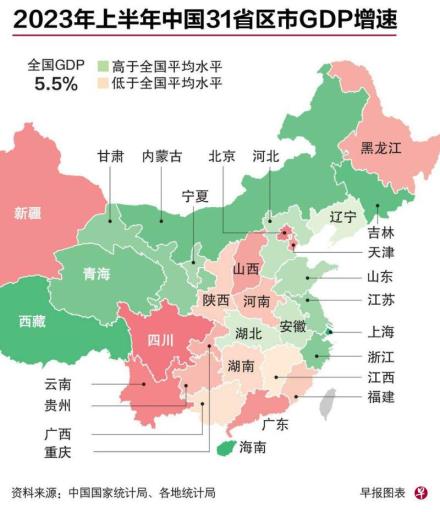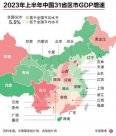
The economic data of 31 provinces and cities in China in the first half of the year (July 30) were released, and the growth rate of most provinces accelerated in the first half of 2023 compared with the first quarter.However, the analysis pointed out that due to the low base of the epidemic in the second quarter of last year, if the growth rate of the first half of the two years was average, most provinces actually slowed down from the first quarter.
Comprehensive data from provinces, based on China's GDP (GDP) in the first half of the year, the year -on -year increase of 5.5%as the benchmark, a total of 15 provinces that are higher than the national average, of which Shanghai led the country 9.7%.Hainan and Tibet ranked second and third with 8.6%and 8.4%, respectively.
Beijing and Sichuan's growth rates are the same as the whole country, and the remaining 14 provinces are less than 5.5%, of which the growth rate of Guangxi and Jiangxi is less than 3%.
Analysis: On the first half of the two years, the growth rate is more reflected in the actual level
Xie Dongming, director of the Research Director of the Greater China of Overseas Chinese, pointed out that last year, the influence of China's economy was affected by crown disease epidemic control, which caused a low base. On average, the GDP growth rate of GDP in various provinces in China in the first half of last year could reflect the actual level.
According to the statistics of Lianhe Zaobao, after the average statistics of the growth rate in the first half of the two years, only Inner Mongolia (5.8%), Shandong (4.9%), Sichuan (4.15%), Xinjiang (5.0%), Guizhou (4.45%)The GDP growth rate of Fujian (4.2%) and the seven provinces of Jiangxi (3.65%) was higher than that of the first quarter of this year, and the growth rate of the remaining provinces slowed down from the first quarter.
It is worth noting that although Sichuan, Xinjiang, Guizhou, Fujian, and Jiangxi, the GDP growth rate is lower than the national average in the first half of this year, after the average growth rate of the first half of the two years, the GDP growth rate was higher than the first quarter.
After the average growth rate of 9.7%9.7%in the first half of this year and the first half of last year, the average GDP growth rate of two years was 2%, which was actually lower than 3%in the first quarter.
Xie Dongming believes that the slowdown of GDP growth in most provinces reflects the general trend of China's economy.Affected by the pressure of foreign trade and lack of effective domestic demand, especially the downside of real estate, the Chinese economy began to lose certain momentum in the second quarter of this year.
The Chinese property market has briefly returned due to the release of backlog requirements earlier this year. In the first quarter, residential sales rose 7.1%year -on -year.However, since April, real estate investment has declined, and sales have fallen, which will affect economic data in the second quarter.
In terms ofIn terms of region, Hainan Province's GDP growth rate is second in the country in the first half of this year, and it can still reach 5.1%after last year.
Lu Xi, an assistant professor at the School of Public Policy of the National University of Singapore, analyzed that the growth of Hainan Province was mainly due to the policy of the service industry and the free trade port.
Official data shows that since the central government announced the support of the Hainan Construction Pilot Zone in 2018, Hainan has increased an average annual GDP by 5.3%in the past five years.In the first half of this year, Hainan Provincial receptions increased by 32.8%year -on -year, and tourism revenue increased by 42.4%year -on -year.
In addition, the average growth rate of Tibet, Inner Mongolia, Qinghai, Sichuan, Chongqing and other western provinces is higher than 4%in the first half of the year, of which Tibet and Inner Mongolia even reached 6.6%and 5.8%.
Xie Dongming believes that the growth rate of western provinces is higher than the national average. In addition to explaining that the policy tilt plays a certain role, it also reflects that some industrial chains are transferred to the west and the west plays the role of production capacity.
The Politburo of the Communist Party of China held a meeting in the second half of the year last week to release the signals that further relax the regulation and stimulate consumption of the property market.The China National Development and Reform Commission also released 20 specific measures to restore and expand consumption on Monday (July 31).
According to Xie Dongming's observation, under a series of policies in July, the market emotions resumed significantly.In addition, as the company's destocking cycle ends in the third quarter, it may also bring support to the economy.
He said: "I think the economy in the second quarter has bottomed out. From the second half of the year, the average growth rate of two years will improve."


